Grow A Laburnum Tree For An Incredible Display Of Cascading Yellow Flowers

TREES > LABURNUM
Reviewed By COLIN SKELLY

Colin is a Horticulturist and Horticultural Consultant with experience in a range of practical and managerial roles across heritage, commercial and public horticulture. He holds the Royal Horticultural Society’s Master of Horticulture award and has a particular interest in horticultural ecology and naturalistic planting for habitat and climate resilience.
IN THIS GUIDE
LABURNUM GUIDES
Laburnums are small ornamental trees with intensely green foliage.
The flowers are even more ‘intense’ in their own way.
Bright golden-yellow links, as if in a chain, tumble and dangle in and from the crown of Laburnum trees in thick, dense clusters, presenting a stunning sight in summer.
Indigenous to Southern Europe, the ‘Golden Chain Tree’ is also prized for its high-grade wood.1Laburnum (Genus Laburnum). (n.d.). iNaturalist United Kingdom. Retrieved March 20, 2023, from https://uk.inaturalist.org/taxa/51811-Laburnum
Laburnums are deciduous trees and they attain heights of 5-8m, with 7m-and-change being a common height.
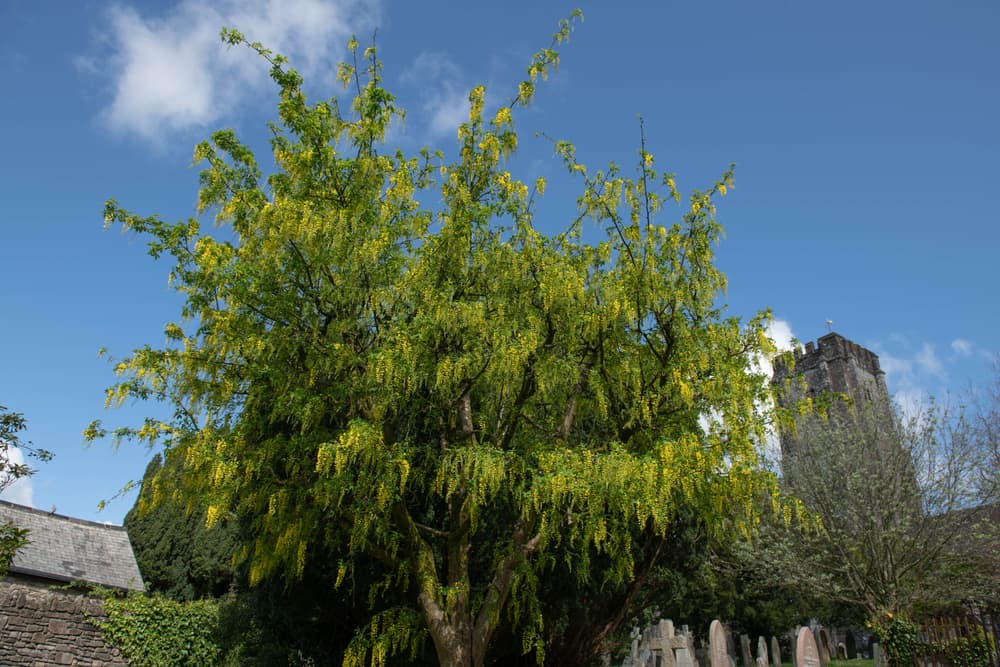
This genus has only three accepted species and several cultivars of which one has become predominant and is so renowned that it is identified by the single word, ‘Vossii’.2Laburnum × watereri “Vossii.” (n.d.). Royal Horticultural Society. Retrieved March 20, 2023, from https://www.rhs.org.uk/plants/44171/laburnum-x-watereri-vossii/details
The three species’ leaves have somewhat different colours, and they also vary as to whether they are smooth or hairy on the underside.
All species’ leaves are trifoliate – that is, each leaf is made up of three leaflets. Such leaves are also called ternate leaves.
The leaflets are lanceolate to ovate and are 2 to 3 centimetres.
Overview
| Botanical Name | Laburnum |
| Common Name(s) | Laburnum Vulgare, Laburnum x Watereri, Golden Chain/Rain Tree |
| Plant Type | Tree |
| Native Area | Europe |
| Hardiness Rating | H6 |
| Foliage | Deciduous |
| Flowers | Bright yellow pea-like flowers |
| When To Sow | September, October |
| Flowering Months | May, June |
| When To Prune | February, March |
Sunlight
Preferred
Full Sun
Exposure
Exposed or Sheltered
Size
Height
4 – 8M
Spread
4 – 8M
Bloom Time
May – June
Soil
Preferred
Most Soil Types
Moisture
Well drained
pH
Any
Though the summer show does not last very long at all, there is a show and the flowers are the stars of the show, which is a spellbinding one.
For about a fortnight – three weeks if you are lucky – the tree produces thick, lush bunches of flowers that appear inter-connected.
These racemes dangle from the branches or cascade or tumble over whatever architectural structure branches have been trained against.
The hue ranges from a bright, cheery yellow to a deep, golden yellow.
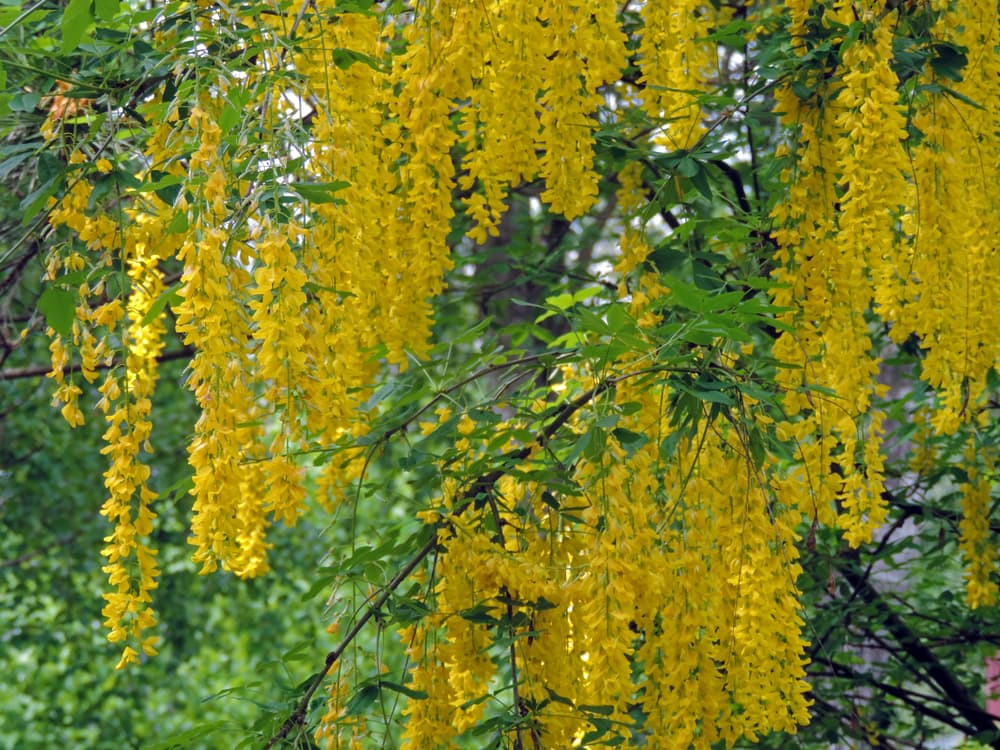
Racemes vary in profusion, density and length by variety of Laburnum.
On the species, the lengths of the racemes range from 12 to 25cm.
However, on the most popular and beautiful of the cultivars, the aforementioned ‘Vossii’, or L. × watereri ‘Vossii’, they reach an amazing length of 60cm. Call them ‘showstoppers.’
The flowers are highly scented; however, the scent is an interesting and perhaps a heady one rather than a sweet perfume.
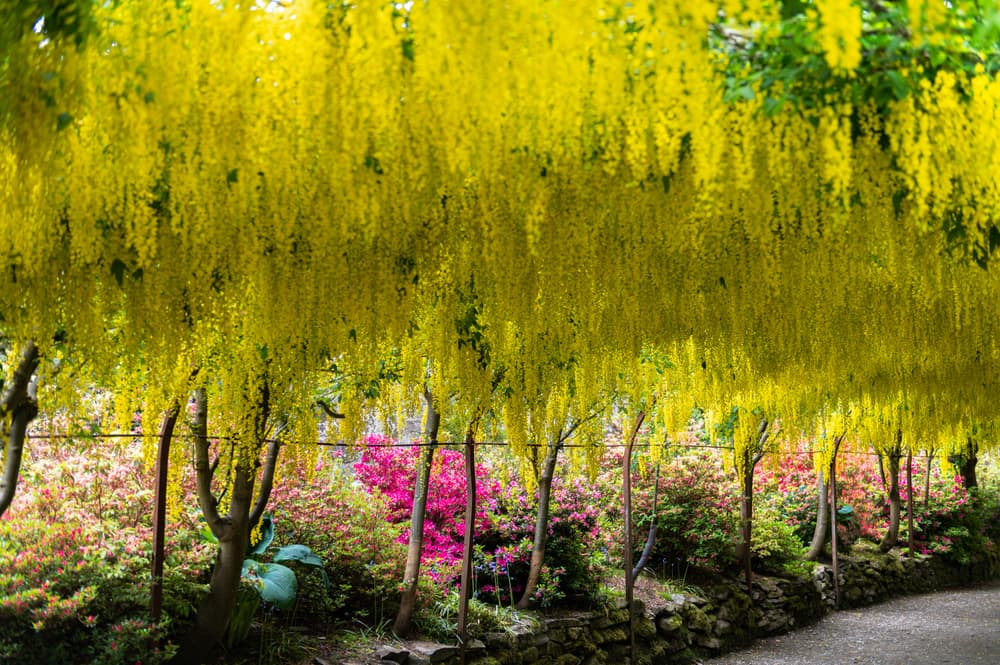
Left alone, Laburnum will grow to be a small, highly-branched tree.
It can be pruned and trained to grow as a shrub, or as an erect tree with a branchless trunk and a heavy crown.
Besides requiring some pruning, Laburnums are susceptible to quite a number of pests and diseases.
As such, it is a high-maintenance plant.
Planting
Laburnums should be planted in spring, preferably mid or late spring.
Laburnums are curiosities because they are average small trees for eleven months of the year but for nearly one month they are an ‘A+’ in ornamental value.
They are sometimes planted in neat rows.
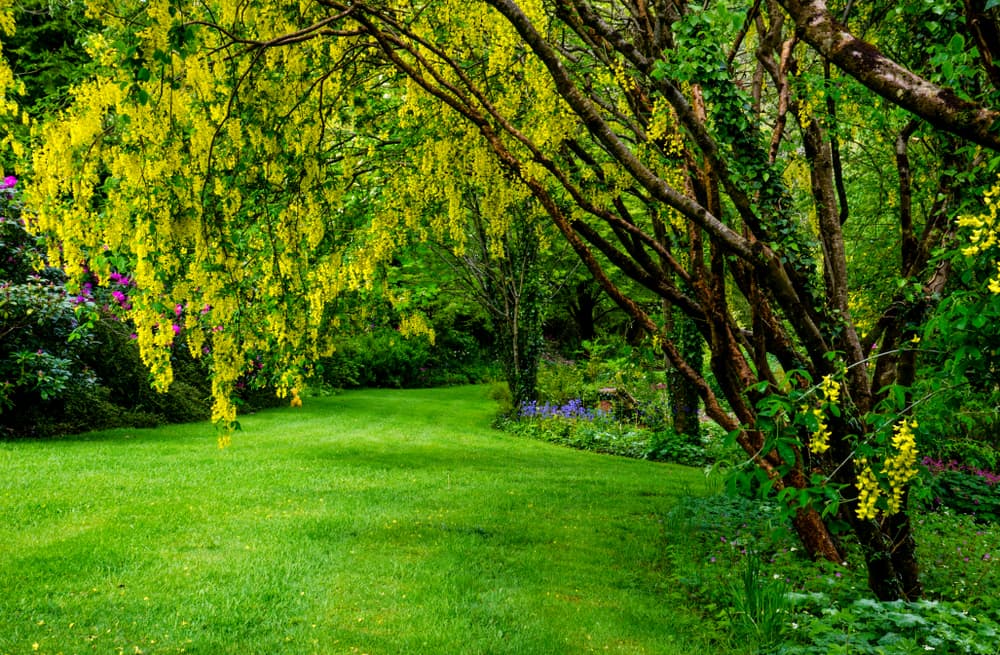
They are commonly trained so that the branches grow over an arch or any wall, or grow flat over a lattice roof of a pergola so that in flowering season it creates a golden-chain ceiling.
“The garden at RHS Wisley has a Laburnum pergola that for many years suffered from late frosts damaging the early summer flowering display,” explains Horticultural Consultant Colin Skelly.3RHS Garden Wisley. (n.d.). Royal Horticultural Society. Retrieved July 3, 2023, from https://www.rhs.org.uk/gardens/wisley
“The curator, Matthew Pottage, tasked the garden team with staying at the garden at night during late frosts and lighting fires under the pergola to keep the frost away from the flower buds.
“It worked, so if this is a problem in your garden, you know what to do!”
These small trees often benefit from a sheltered location, especially in cold and blustery regions.
As their roots are non-invasive, they can be grown right beside all kinds of structures, such as a patio or boundary wall.4Gilman, E., & Watson, D. (n.d.). Laburnum spp. US Forest Survey. Retrieved March 20, 2023, from https://hort.ifas.ufl.edu/database/documents/pdf/tree_fact_sheets/labsppa.pdf

Habitat & Growing Conditions
As natives of Western and Southern Europe Laburnums prefer cooler climes and are not exactly tolerant of high heat or humidity.
They are also not tolerant of frigid weather, as may be inferred by their Hardiness Zones.
Laburnum is classified as H6 by the RHS; making it hardy in all regions of the UK.

Cool summers and moderate winters are ideal for Laburnums.
In colder climates or regions that do not get sunny and hot in the summer, Laburnums should get full sun.
Otherwise, they should be protected from the midday and afternoon sun.
Latitude also dictates where you should grow a Laburnum.
Up in County Ross it should be grown in full sun; down in Gibraltar, in part sun.
Care & Growing Tips
Laburnums are best planted in autumn.
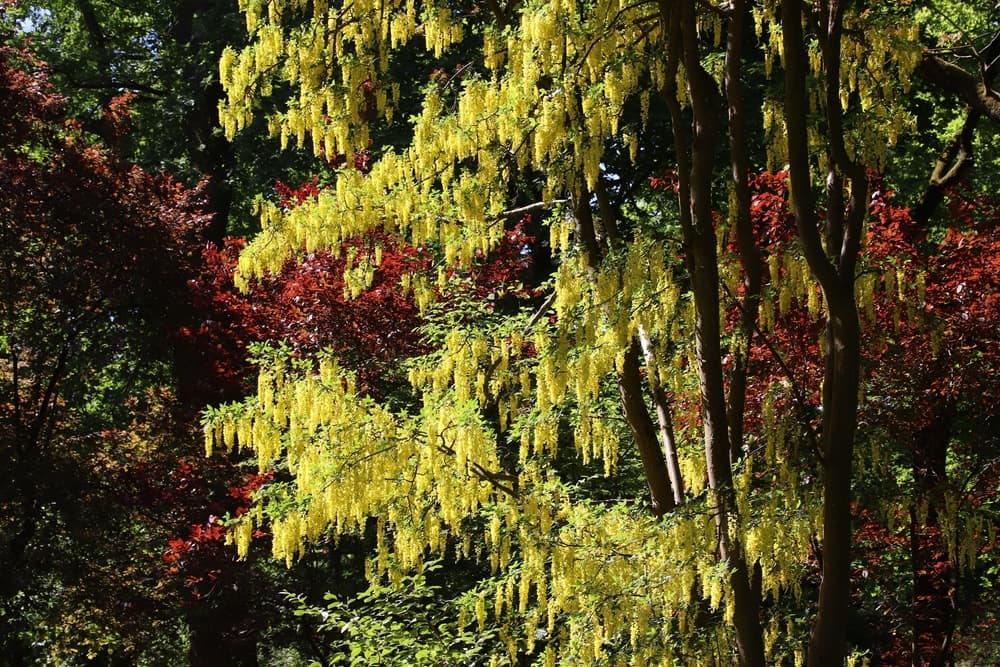
Young trees need support and should be staked.
Though these trees are not fussy about soil, start them off with some compost or manure.
Laburnums grow well in any soil as long as it is not too acidic or too alkaline; pH slightly alkaline to slightly acidic soil will do just fine.
A good loam mix is ideal. Soil should be very well drained; above all, Laburnums will not tolerate waterlogged soil.

Mature plants should be watered once a week or very lightly twice a week.
Though Laburnums are fairly drought-tolerant, in hot climates the soil should be kept moist in spring and summer.
It may be fertilised every spring with an organic 10-20-10 or a rich compost.
Pruning Laburnum Tree
Laburnums can be grown as a bushy shrub, a fastigiate tree, and anything in between.
It depends on how you prune and train it.
If you would like to grow the relatively unusual Laburnum shrub, on the young tree cut back the leader but let the secondary stems grow.
If you would like it to grow tall and erect, prune all secondary stems.

In either case, when it is a sapling you will need to stake it.
When to prune, though? Some experts opt for late-summer when the flowering season is over and the tree is growing and full of life.
Others propose winter when the tree is dormant and growth is at a halt.
However, we know when not to prune Laburnum. Do not prune in spring or early summer as the tree will ‘bleed’ and it will be susceptible to infections.
What you should ‘prune’ are the seed pods, and for dual reasons at that.
To begin with, they are not exactly decorative. More importantly, they draw away the vigour of the tree.
Common Problems
All Laburnum varieties are very prone to pests and diseases.
Pests include snails, aphids, mealybugs, and leaf miners – all three, Lepidoptera, Diptera, and Hymenoptera.
Diseases include canker, twig blight, leaf spot, powdery mildew, and silver leaf.
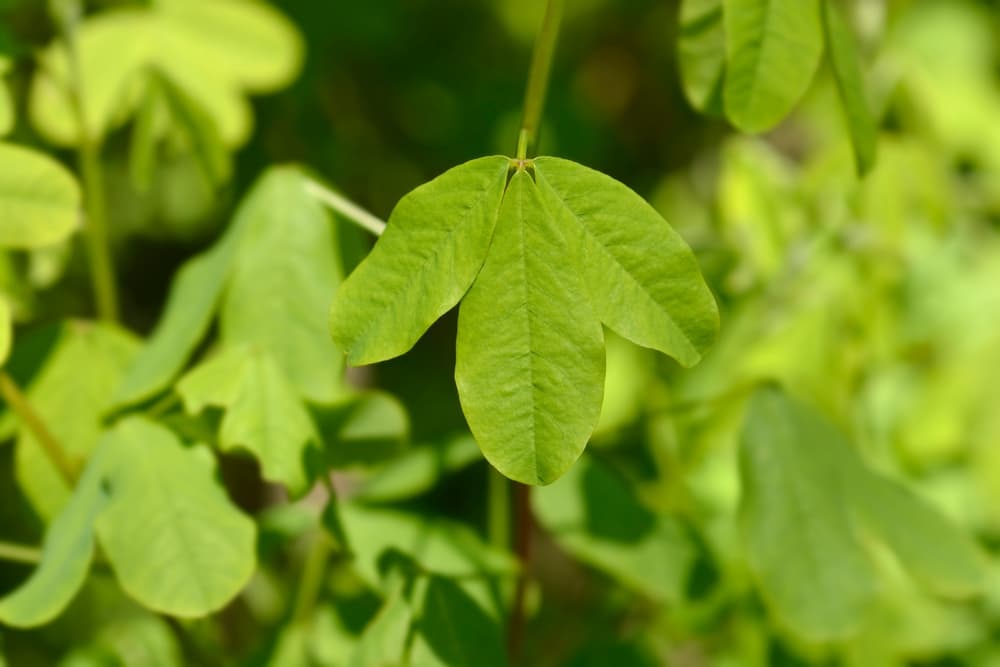
At least most deer will steer clear of Laburnum – most, but not all!
Obviously, Laburnums are not low-care trees.
You will need to learn about treatments and counteracting organisms such as beneficial nematodes, lacewings, and mealybug destroyers.
Infestations like powdery mildew and twig blight can just about only be resolved by cutting off affected parts of the tree with sterilised pruning implements.

Uses Of Laburnum Wood
In general, Laburnum trunks yield a high-quality wood, and L. alpinum heartwood is one of the most sought-after woods.
It is very hard, has an appealing yellowish-brown colour, is very shiny and can be polished to a lovely sheen.
With such a list of attributes is it any wonder that this wood is described as ‘highly prized’?

L. alpinum wood, particularly the heartwood, is one of the top choices for cabinet-making and parquetry.
Flutes, recorders, and bagpipes used to be made almost exclusively with Laburnum wood, and these musical instruments are still made from this wood, among others.
Sourcing Laburnum
L. × watereri ‘Vossii’ is widely available and is very easy to find in nurseries and garden centres.
The three species are also available, though at a more limited number of nurseries.
Specialist nurseries offer one or two of the old, established cultivars and one or two newer ones.
References
- 1Laburnum (Genus Laburnum). (n.d.). iNaturalist United Kingdom. Retrieved March 20, 2023, from https://uk.inaturalist.org/taxa/51811-Laburnum
- 2Laburnum × watereri “Vossii.” (n.d.). Royal Horticultural Society. Retrieved March 20, 2023, from https://www.rhs.org.uk/plants/44171/laburnum-x-watereri-vossii/details
- 3RHS Garden Wisley. (n.d.). Royal Horticultural Society. Retrieved July 3, 2023, from https://www.rhs.org.uk/gardens/wisley
- 4Gilman, E., & Watson, D. (n.d.). Laburnum spp. US Forest Survey. Retrieved March 20, 2023, from https://hort.ifas.ufl.edu/database/documents/pdf/tree_fact_sheets/labsppa.pdf

